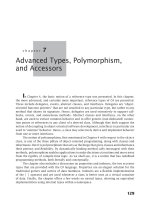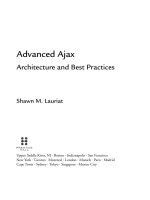Advanced Types, Polymorphism, and Accessors
Bạn đang xem bản rút gọn của tài liệu. Xem và tải ngay bản đầy đủ của tài liệu tại đây (463.89 KB, 34 trang )
chapter
7
Advanced Types, Polymorphism,
and Accessors
I
n Chapter 4, the basic notion of a reference type was presented. In this chapter,
the more advanced, and certainly more important, reference types of C# are presented.
These include delegates, events, abstract classes, and interfaces. Delegates are “object-
oriented function pointers" that are not attached to any particular type, but rather to any
method that shares its signature. Hence, delegates are used extensively to support call-
backs, events, and anonymous methods. Abstract classes and interfaces, on the other
hand, are used to extract common behavior and to offer generic (non-dedicated) connec-
tion points or references to any client of a derived class. Although they both support the
notion of decoupling in object-oriented software development, interfaces in particular are
used to “atomize” behavior. Hence, a class may selectively derive and implement behavior
from one or more interfaces.
The notion of polymorphism, first mentioned in Chapter 4 with respect to the object
class, is one of the three pillars of object-oriented programming, along with classes and
inheritance. But it is polymorphism that acts as the hinge that gives classes and inheritance
their potency and flexibility. By dynamically binding method calls (messages) with their
methods, polymorphism enables applications to make decisions at runtime and move away
from the rigidity of compile-time logic. As we shall see, it is a notion that has redefined
programming methods, both literally and conceptually.
The chapter also includes a discussion on properties and indexers, the two accessor
types that are provided with the C# language. Properties are an elegant solution for the
traditional getters and setters of data members. Indexers are a flexible implementation
of the []operator and are used whenever a class is better seen as a virtual container
of data. Finally, the chapter offers a few words on nested types, showing an equivalent
implementation using internal types within a namespace.
129
130
Chapter 7: Advanced Types, Polymorphism, and Accessors
■
7.1 Delegates and Events
A delegate is a reference type to an instance or static method that shares the same sig-
nature as the delegate itself. Therefore, any instance of a delegate can refer to a method
that shares its signature and thereby “delegate” functionality to the method to which it is
assigned. In order to encapsulate an instance or static method, the delegate is instantiated
with the method as its parameter. Of course, if the method does not share the same sig-
nature as the delegate, then a compiler error is generated. Hence, delegates are type-safe
and are declared according to the following EBNF definition:
EBNF
DelegateDecl = DelegateModifiers? "delegate"
Type Identifier "(" FormalParameters? ")" ";" .
Delegates are derived from a common base class System.Delegate and are an important
feature of the C# language. They are used to implement callbacks, support events, and
enable anonymous methods, each of which is described in greater detail in the following
three subsections.
7.1.1 Using Delegates for Callbacks
Generally, using delegates involves three steps: declaration, instantiation, and invoca-
tion. Each of these steps is illustrated with the following example, where two classes,
Message and Discount, use delegates MessageFormat and DiscountRule. The two delegates
encapsulate message formats and discount rules, respectively.
1 delegate double DiscountRule(); // Declaration
2 delegate string MessageFormat(); // Declaration
3
4 class Message {
5 public string Instance() { return "You save {0:C}"; }
6 public static string Class() { return "You are buying for {0:C}"; }
7 public void Out(MessageFormat format, double d) {
8 System.Console.WriteLine(format(), d);
9}
10 }
11 class Discount {
12 public static double Apply(DiscountRule rule, double amount) {
13 return rule()*amount; // Callback
14 }
15 public static double Maximum() { return 0.50; }
16 public static double Average() { return 0.20; }
17 public static double Minimum() { return 0.10; }
18 public static double None() { return 0.00; }
19 }
20 class TestDelegate1 {
21 public static void Main() {
■
7.1 Delegates and Events
131
22 DiscountRule[] rules = { // Instantiations
23 new DiscountRule(Discount.None),
24 new DiscountRule(Discount.Minimum),
25 new DiscountRule(Discount.Average),
26 new DiscountRule(Discount.Maximum),
27 };
28 // Instantiation with a static method
29 MessageFormat format = new MessageFormat(Message.Class);
30
31 double buy = 100.00;
32 Message msg = new Message();
33
34 msg.Out(format, buy); // Invocation
35
36 // Instantiation with an instance method
37 format = new MessageFormat(msg.Instance);
38
39 foreach (DiscountRule r in rules) {
40 double saving = Discount.Apply(r, buy); // Invocation
41 msg.Out(format, saving); // Invocation
42 }
43 }
44 }
On lines 1 and 2, the delegates, DiscountRule and MessageFormat, are first declared.
Since an instance of a delegate may only refer to a method that shares its signature,
instances of both delegates in this case may only refer to methods without parameters. It
is worth noting that unlike a method, the return type is part of a delegate’s signature. On
lines 22–27, 29, and 37, six delegates are instantiated. Delegates for the four discount rules
are stored in an array called rules of type DiscountRule. Delegates for message formats
are assigned on two occasions to a reference variable called format of type MessageFormat.
In the first assignment on line 29, format refers to the static method Class. On the second
assignment on line 37, format refers to the instance method Instance. It is important to
remember that the method passed as a parameter can only be prefixed by the class name
(Message) for a static method and by an object name (msg) for an instance method. All
methods of rules are static and, therefore, prefixed by their class name Discount.
Once the delegates have been instantiated, the methods to which they refer are
invoked or “called back.” On line 34, the first instance of format is passed to the method
Out along with the parameter buy. Within Out, the method Class is invoked. The string
that Class returns is then used as part of the buy message. For each execution of the
foreach loop from lines 39 to 42, a different discount method is passed to the static
method Apply. Within Apply on line 13, the appropriate discount rule is invoked and the
saving is returned. On line 41, the second instance of format is passed to the method
Out along with the parameter saving. This time, the method Instance is “called back”
132
Chapter 7: Advanced Types, Polymorphism, and Accessors
■
within Out and returns a string that is used as part of the saving message. The output of
TestDelegate1 is given here:
You are buying for $100.00
You save $0.00
You save $10.00
You save $20.00
You save $50.00
In C#, more than one delegate can be subscribed in reaction to a single callback. But in
order to do so, each delegate object must have a void return value. The following example
illustrates how to display different integer formats (views).
1 delegate void IntView(int c);
2
3 class View {
4 public static void AsChar(int c) {
5 System.Console.Write("’{0}’ ", (char)c);
6}
7 public static void AsHexa(int c) {
8 System.Console.Write("0x{0:X} ", c);
9}
10 public static void AsInt(int c) {
11 System.Console.Write("{0} ", c);
12 }
13 }
14 class TestDelegate2 {
15 public static void Main() {
16 IntView i, x, c, ic, all;
17
18 i = new IntView(View.AsInt);
19 x = new IntView(View.AsHexa);
20 c = new IntView(View.AsChar);
21
22 System.Console.Write("\ni: "); i(32);
23 System.Console.Write("\nx: "); x(32);
24 System.Console.Write("\nc: "); c(32);
25
26 all=i+x+c; //callbacks in that order
27 System.Console.Write("\nall: "); all(32);
28
29 ic = all - x;
30 System.Console.Write("\nic: "); ic(32);
31 }
32 }
■
7.1 Delegates and Events
133
The delegate IntView is first declared on line 1. Hence, any instance of IntView may only
refer to a void method that has a single int parameter. The class View from lines 3 to
13 groups together three methods that output a different view of an integer parameter.
Three delegates of IntView are instantiated on lines 18–20 and are assigned to each of
the three static methods in View. The methods are invoked separately on lines 22–24
with the integer parameter 32. A fourth (composite) delegate called all combines the
other three delegates into one using the + operator. When all is invoked on line 27, each
method in the combination is invoked in turn. Finally, a delegate can be removed from
a combination using the — operator as shown on line 29. The output of TestDelegate2 is
shown here:
i: 32
x: 0x20
c: ’ ’
all: 32 0x20 ’ ’
ic: 32 ’ ’
7.1.2 Using Delegates for Events
An event, another reference type, is simply an occurrence within a program environment
that triggers an event handler to perform some action in response. It is analogous in many
ways to an exception that is raised and dealt with by an exception handler. However,
the handling of an event is achieved using a callback. Event programming is common in
graphical user interfaces where input from the user, such as a button click, notifies one or
more event handlers to react to its activation.
In C#, one class called the source or subject class fires an event that is handled
by one or more other classes called listener or observer classes. Events themselves
are declared by placing the keyword event before the declaration of a delegate in the
source class. Handlers are associated with an event by combining delegates from observer
classes. In the following example, the Subject class defines an event called Changed on
line 7.
1 delegate void UpdateEventHandler();
2
3 class Subject {
4 private int data;
5 public int GetData() { return data; }
6 public void SetData(int value) { data = value; Changed(); }
7 public event UpdateEventHandler Changed;
8}
9 class Observer {
10 public Observer(Subject s) { subject = s; }
11 public Subject GetSubject() { return subject; }
12 private Subject subject;
13 }
134
Chapter 7: Advanced Types, Polymorphism, and Accessors
■
14 class HexObserver : Observer {
15 public HexObserver(Subject s) : base(s) {
16 s.Changed += new UpdateEventHandler(this.Update);
17 }
18 public void Update() {
19 System.Console.Write("0x{0:X} ", GetSubject().GetData());
20 }
21 }
22 class DecObserver : Observer {
23 public DecObserver(Subject s) : base(s) {
24 s.Changed += new UpdateEventHandler(this.Update);
25 }
26 public void Update() {
27 System.Console.Write("{0} ", GetSubject().GetData());
28 }
29 }
30 class TestEvent {
31 public static void Main() {
32 Subject s = new Subject();
33 HexObserver ho = new HexObserver(s);
34 DecObserver co = new DecObserver(s);
35
36 for (int c;;) {
37 System.Console.Write("\nEnter a character"+
38 "(followed by a return, ctrl-C to exit): ");
39 c = System.Console.Read();
40 s.SetData( c );
41 System.Console.Read(); // Two reads to get rid of the \r\n on PC.
42 System.Console.Read();
43 }
44 }
45 }
On line 32, an instance of Subject is created and assigned to s. Its data field is initialized
by default to 0 and its Changed event is initialized by default to null (keep in mind that a
delegate is a reference type). In order to attach handlers to the event Changed of instance
s, the constructors of the two observer classes, in this case HexObserver and DecObserver,
are invoked with the parameter s on lines 33 and 34. Each constructor then assigns their
respective Update methods (handlers) to the delegate Changed of instance s on lines 16
and 24. It is important to note that the Update methods in both cases must have the same
signature as UpdateEventHandler. Otherwise, a compilation error is generated. After a
character c is input from the user on line 39, the SetData method of s is invoked on
line 40. In addition to updating the data field of s, the event Changed “calls back” each of
its associated handlers.
■
7.1 Delegates and Events
135
7.1.3 Using Delegates for Anonymous Methods
In the previous sections, a callback or event handler was implemented as a method, and
when delegates were later instantiated, the method was passed as a parameter. For exam-
ple, the Update method on lines 18–20 in the previous HexObserver class was later passed
as a parameter on line 16 upon the instantiation of the UpdateEventHandler delegate. An
anonymous method, on the other hand, allows the body of a callback method or event
handler to be declared inline, where the delegate is instantiated as shown here:
class HexObserver : Observer {
public HexObserver(Subject s) : base(s) {
s.Changed += delegate { System.Console.Write("0x{0:X} ",
GetSubject().GetData()); };
}
}
An anonymous method is declared with the keyword delegate followed by a parameter list.
C# 2.0
The inline code is surrounded by braces {}. In the previous case, there was no parameter
list because the UpdateEventHandler delegate had no parameters. For the delegate IntView
with a single int parameter, the class View can be eliminated altogether using anonymous
methods as shown here:
delegate void IntView(int v);
class TestDelegate2 {
public static void Main() {
IntView i, x, c, ic, all;
i = delegate(int v) { System.Console.Write("’{0}’ ", (char)v); };
x = delegate(int v) { System.Console.Write("0x{0:X} ", v); };
c = delegate(int v) { System.Console.Write("{0} ", v); };
System.Console.Write("\ni: "); i(32);
System.Console.Write("\nx: "); x(32);
System.Console.Write("\nc: "); c(32);
all=i+x+c; //callbacks in that order
System.Console.Write("\nall: "); all(32);
ic = all - x;
System.Console.Write("\nic: "); ic(32);
}
}
Anonymous methods are particularly useful in event programming or callback intensive
applications used to declare methods (usually delegates) inline with the declaration of the
event.
136
Chapter 7: Advanced Types, Polymorphism, and Accessors
■
7.1.4 Using Delegate Inferences
A delegate variable may be initialized by passing a method name to the instantiation of
its delegate constructor. On line 5 of this example, the variable d is assigned as a delegate
for the method Act:
1 class C {
2 delegate void D();
3 public void Act() { }
4 public void DoAction() {
5 D d = new D(Act);
6 // ...
7 d();
8}
9}
A delegate inference, on the other hand, directly assigns a method name to a delegate
C# 2.0
variable. Based on the previous example, line 5 can be replaced by:
D d = Act;
In fact, the C# compiler deduces the specific delegate type and creates the equivalent
delegate object underneath.
7.2 Abstract Classes
An abstract class is a class that defines at least one member without providing its imple-
mentation. These specific members are called abstract and are implicitly virtual. Members
can be methods, events, properties, and indexers. The latter two are presented later in
this chapter. Because at least one method is not implemented, no instance of an abstract
class can be instantiated since its behavior is not fully defined. Furthermore, a subclass
of an abstract class can only be instantiated if it overrides and provides an implementa-
tion for each abstract method of its superclass. If a subclass of an abstract class does not
implement all abstract methods that it inherits, then the subclass is also abstract.
7.2.1 Declaring Abstract Classes
The declaration of an abstract class is similar to that of a class:EBNF
AbstractClassDecl = AbstractClassModifiers? "abstract" "class"
Identifier ClassBase? ClassBody ";"? .
AbstractClassModifier = "public" | "protected" | "internal" | "private" .
However, it is very important to point out that the access modifiers of an abstract class
and those of structures, enumerations, delegates, and interfaces (discussed in the next
■
7.2 Abstract Classes
137
section) are context dependent. Within a namespace, these type declarations are limited
to public or internal. In this context, if the access modifier is not specified then internal
is assumed by default. Additional modifiers such as new, protected, and private may be
applied to each type of declaration when the declaration is nested within a class. For this
case, all applicable modifiers for each type declaration are given in Appendix A. As a final
note, neither data nor static methods can be abstract.
7.2.2 Implementing Abstract Classes
An abstract class is most appropriate if it implements some default behavior common
to many subclasses and delegates, and the rest of its behavior as specialized implemen-
tations. In fact, if all methods are abstract, then it is better to define an interface, as
described in the next section, instead of an abstract class. Consider now an abstract class
called Counter as defined here.
1 using System;
2
3 namespace SubclassConstructors {
4 abstract class Counter {
5 public Counter(int c) { count = c; }
6 public abstract void Tick();
7
8 public int GetCount() { return count; }
9 protected void Inc() { ++count; }
10 protected void Dec() { --count; }
11
12 private int count;
13 }
14
15 class DownCounter : Counter {
16 public DownCounter(int count) : base(count) { }
17 public override void Tick() { Dec(); }
18 }
19
20 class UpCounter : Counter {
21 public UpCounter(int count) : base(count) { }
22 public override void Tick() { Inc(); }
23 }
24
25 public class TestAbstractCounter {
26 public static void Main() {
27 Counter[] counters = { new UpCounter(0), new DownCounter(9) };
28
29 for(intc=0;c<counters.Length ; c++) {
138
Chapter 7: Advanced Types, Polymorphism, and Accessors
■
30 Console.WriteLine("Counter starting at: "
31 +counters[c].GetCount());
32 for(intn=0;n<5;n++) {
33 Console.Write(counters[c].GetCount());
34 counters[c].Tick();
35 }
36 Console.WriteLine();
37 }
38 }
39 }
40 }
The methods GetCount, Inc, and Dec are fully implemented and, hence, represent com-
mon behavior for all subclasses that may derive from Counter. The Tick method, on the
other hand, is abstract, requiring subclasses to implement Tick according to their own
needs. The two subclasses, DownCounter and UpCounter, inherit from Counter. When Tick
is implemented by either subclass, it must be preceded by the modifier override as shown
in lines 17 and 22. Hence, implementations are specialized for DownCounter and UpCounter.
In this case, the subclass DownCounter decrements count in its implementation of Tick,
and the subclass UpCounter increments count in its implementation of Tick. If no modi-
fier precedes an inherited method, a warning and an error is generated indicating that the
inherited method in the subclass hides the corresponding method of its parent. But if that
is the intent, then the method Tick must be preceded, instead, by the modifier new.
7.2.3 Using Abstract Classes
In the previous class, TestAbstractCounter, the Main method declares an array of Counter
called counters. The array is initialized to one instance each of DownCounter and UpCounter
(line 27) and, hence, has a length of two. The instance of DownCounter has an initial value
of 9, and the instance of UpCounter has an initial value of 0. For each instance, the method
Tick is invoked five times (lines 32–35). Depending on whether or not it is an instance of
DownCounter or UpCounter, the count is either decremented or incremented as shown by
the following output:
Counter starting at: 0
01234
Counter starting at: 9
98765
7.3 Interfaces
An interface is a special type of abstract class. It provides the signature, but no implemen-
tation of all its members. Therefore, an interface cannot define data fields, constructors,
■
7.3 Interfaces
139
static methods, and constants. Only instance methods, events, properties, and indexers
are permitted, and of course, must be abstract. Like an abstract class, an interface can-
not be instantiated and cannot inherit from multiple abstract classes. However, unlike an
abstract class, any subclass that inherits an interface must implement all members of the
interface. If all interface members are not implemented by the concrete subclass, then
a compilation error is generated. On the other hand, a compilation error is not gener-
ated if an abstract class is not fully implemented by its subclass. For example, a subclass
inheriting from an abstract class may only implement two of four abstract methods. The
other two methods and the subclass itself remain abstract. Hence, abstract classes give
subclasses the freedom to implement or delegate abstract members. Because a subclass
may delegate implementation of an abstract member down the class hierarchy, there is
no guarantee that a subclass is fully implemented. This freedom, though, is not always
useful, especially if the client seeks assurance that a given subclass can be instantiated.
For these reasons, we typically say that a subclass “inherits from” an abstract class but
“implements” an interface.
In C#, a class can inherit from only one base class but can implement any number of
interfaces. This feature is called “single inheritance of classes with multiple inheritance
of interfaces.” Like subclasses, an interface can also tailor a specific behavior by inher-
iting from multiple interfaces. But unlike subclasses, an interface does not, and cannot
by definition, implement the abstract members of its parent interface. That remains the
responsibility of the subclass.
In the .NET Framework, interfaces are often limited to a single method, which reduces
Tip
the likelihood that undesired behavior is inherited. This approach supports the golden
rule of inheritance: Always be completely satisfied with inherited behavior. Dealing with
interfaces that contain only one method also allows one to pick and choose (by inheritance)
those methods that will constitute a new “assembled” behavior. The result is exactly the
right combination of methods, no more and no less. For many years, the design-pattern
community has promoted the adage: Program to an interface, not to an implementation.
7.3.1 Declaring Interfaces
The declarations of an interface and an abstract class are very similar. Other than their
semantic differences concerning inheritance, the interface ICountable given here:
interface ICountable {
bool Tick();
}
is equivalent to the abstract class ACountable:
abstract class ACountable {
public abstract bool Tick();
}
The ICountable interface prescribes common behavior for all subclasses that inherit from
it. Once implemented in a subclass, for example, the method Tick may “bump a count” and
140
Chapter 7: Advanced Types, Polymorphism, and Accessors
■
return true once a maximum or minimum value has been reached. Syntactically, interface
members, such as Tick, are implicitly public and abstract. In fact, no modifier for inter-
face members can be used other than new, which permits an interface member to hide its
inherited member. It is also good programming practice to begin an interface name with a
Tip
capital “I” to distinguish it from a class. The full syntax of an interface declaration is given
here:
EBNF
InterfaceDecl = InterfaceModifiers? "interface" Identifier (":" Interfaces)? "{"
InterfaceMembers
"}" ";"? .
InterfaceModifier = "new" | "public" | "protected" | "internal" | "private" .
InterfaceMember = MethodDecl | PropertyDecl | EventDecl | IndexerDecl .
Now consider two common interface declarations. The ICloneable interface declared here
is used to create copies of an existing object:
public interface ICloneable {
object Clone();
}
Because the return type of Clone is an object reference of the root class, the method Clone
is able to return any instance of any class. Another useful interface is IComparable whose
method CompareTo compares two objects of the same type.
public interface IComparable {
int CompareTo(object o);
}
Once implemented in a subclass, for example, the method CompareTo may return a nega-
tive integer if the current object is “less than” its object parameter, zero if it is equal, and
a positive integer if it is “greater than.” In any case, any class that implements ICountable,
ICloneable,orIComparable must implement their respective methods in some way. The
implementation, however, does not place semantic constraints on the programmer. The
method CompareTo in this case, and the previous methods Tick and Clone, may be imple-
mented in any way as along as the signature of the behavior is satisfied. Common behavior,
therefore, means common use of abstract members. Nonetheless, actual behavior as
defined by implementation should be predictable and disciplined as shown in the following
section.
7.3.2 Implementing Interfaces
As previously pointed out, the members of an interface must be implemented by the class
that inherits it. In the following example, the Counter class inherits part of its behavior
from the interface ICountable, namely the Tick method. Other methods include ToString
that is overridden from the Object class as well as GetCount and SetCount that return and
initialize count, respectively.
■
7.3 Interfaces
141
class Counter : ICountable {
public Counter(int c) { count = c; }
public Counter() : this(0) { }
public override string ToString() { return ""+count; }
// same as count.ToString()
public int GetCount() { return count; }
protected void SetCount(int c) { count = c; }
public bool Tick() { return ++count == System.Int32.MaxValue; }
private int count;
}
The implementation of Tick increments count by one and returns true once the maximum
integer value Int32.MaxValue is reached.
If it is recognized that all counters, in addition to those defined by Counter, exhibit
a common behavior described by GetCount, then that behavior is best encapsulated and
explicitly defined as an interface:
public interface IRetrievable {
int GetCount();
}
Furthermore, to make copies of Counter objects, the Counter class may also implement
ICloneable. The final changes to the class Counter are highlighted here:
class Counter : ICountable, IRetrievable, ICloneable {
...
public object Clone() { return this.MemberwiseClone(); }
...
}
The class Counter now inherits and implements three interfaces, and each one includes
only a single method. Because the signature of the GetCount method in Counter is the same
as the corresponding method in IRetrievable, its definition is unaffected. The description
for MemberwiseClone is found in Chapter 4; it is implicitly inherited from the root class
Object.
7.3.3 Using Interface Methods
Because an interface is typically small and defines a limited behavior, several classes are
likely to implement the same interface. Therefore, instances of classes like the following,
Counter and BoundedCounter, share a common behavior:
public class Counter : ICloneable, IRetrievable {...}
public class BoundedCounter : IRetrievable {...}









